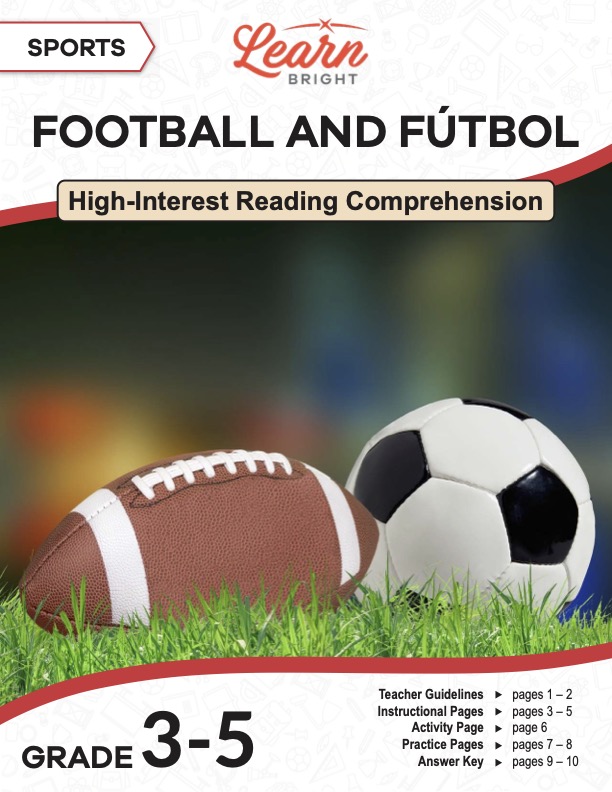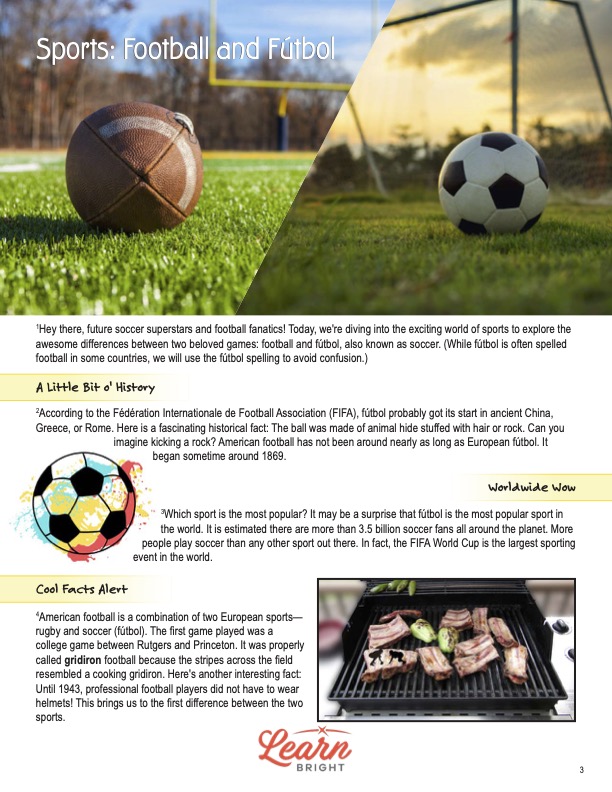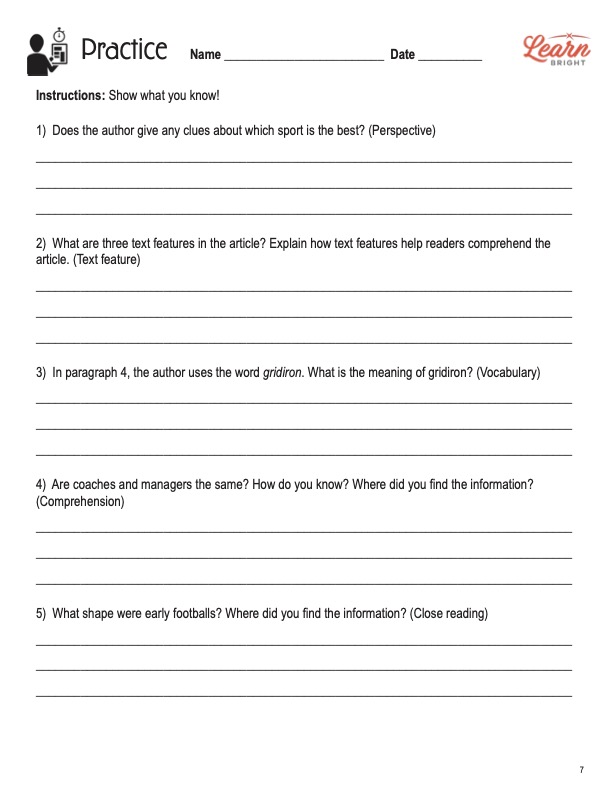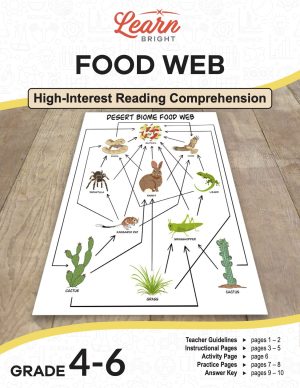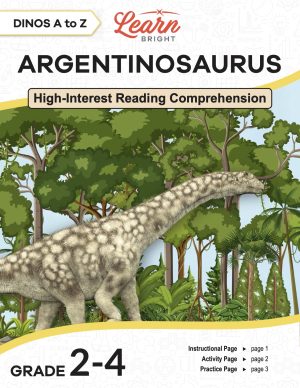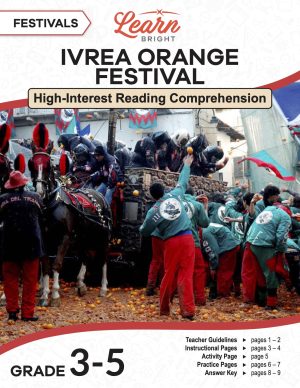Description
What our Sports: Football and Fútbol lesson plan includes
Lesson Objectives and Overview: Sports: Football and Fútbol is a high-interest reading comprehension lesson plan. As such, students will practice various close reading and comprehension skills. In addition, they will learn about these two different but similar-sounding sports. This lesson is for students in 3rd grade, 4th grade, and 5th grade.
Classroom Procedure
Every lesson plan provides you with a classroom procedure page that outlines a step-by-step guide to follow. You do not have to follow the guide exactly. The guide helps you organize the lesson and details when to hand out worksheets. It also lists information in the yellow box that you might find useful. You will find the lesson objectives, state standards, and number of class sessions the lesson should take to complete in this area. In addition, it describes the supplies you will need as well as what and how you need to prepare beforehand. The activity in this lesson requires a timer, large or extra-large balloons, and blue painter’s tape or rope to mark sidelines and goals.
Teacher Notes
The paragraph on this page provides a little more information or guidance on what to expect from the lesson. It explains that you can teach this lesson in a whole-class setting or as an independent, small-group activity. You can use the blank lines to record any thoughts or ideas you have as you prepare.
SPORTS: DISC GOLF LESSON PLAN CONTENT PAGES
History and Fame of Football and Fútbol
The Sports: Football and Fútbol lesson plan contains three content pages. Hey there, future soccer superstars and football fanatics! Today, we’re diving into the exciting world of sports to explore the awesome differences between two beloved games: football and fútbol, also known as soccer. (While fútbol is often spelled football in some countries, we will use the fútbol spelling to avoid confusion.)
According to the Federation Internationale de Football Association (FIFA), fútbol probably got its start in ancient China, Greece, or Rome. Here is a fascinating historical fact: The ball was made of animal hide stuffed with hair or rock. Can you imagine kicking a rock? American football has not been around nearly as long as European fútbol. It began sometime around 1869.
Which sport is the most popular? It may be a surprise that fútbol is the most popular sport in the world. It is estimated there are more than 3.5 billion soccer fans all around the planet. More people play soccer than any other sport out there. In fact, the FIFA World Cup is the largest sporting event in the world.
American football is a combination of two European sports—rugby and soccer (fútbol). The first game played was a college game between Rutgers and Princeton. It was properly called gridiron football because the stripes across the field resembled a cooking gridiron. Here’s another interesting fact: Until 1943, professional football players did not have to wear helmets! This brings us to the first difference between the two sports.
Gathering the Gear
Let’s talk about the gear! In football, players wear helmets, pads, and jerseys. It’s like they’re gearing up for battle on the field! But in fútbol, you only need a pair of cleats, shin guards, and your trusty jersey. No helmets are required here. Just your skills and spirit!
As another difference, let’s look at the shape of the ball. Footballs are oval-shaped, like a big, brown egg ready to toss around. In the early football games, however, the ball was round. It wasn’t until 1874 that players started using an oval rugby ball. In fútbol, the ball is round like the sun, perfect for dribbling, passing, and scoring goals. However, in medieval times, teams used animal skulls or pig bladders as the ball!
How to Play Football and Fútbol
In football, you earn points by carrying the ball into the end zone or kicking it through the uprights. It’s all about touchdowns and field goals. But in fútbol, the goal is to kick the ball into the net to score a goal. Players can’t use their hands, unless they’re the goalie.
Speaking of players, both sports’ teams have different positions. Each player has a specific job, like puzzle pieces fitting together to create the perfect play. In American football, positions include quarterback, running back, and wide receiver. In soccer, players have goalie, forward, midfielder, and defender positions. They work together to control the ball and outmaneuver the opposing team.
Yet another difference is between the sports’ fields. They may look alike, but there are quite a few differences. Football fields are big rectangles of green grass marked with bright white lines around the edges. They’re 100 yards long (plus a 10-yard end zone on each side) and 53 and 1/3 yards wide. With soccer fields, instead of yards, soccer players use meters to measure how far they are from the goal. And these fields are even bigger. They are about 100 meters long (about 110 yards) and 64 meters (about 70 yards) wide. Professional fields are bigger still at 110 meters (about 120 yards) long and 73 meters (about 80 yards) wide. There are grid lines 10 yards apart on football fields. On fútbol fields, white lines mark only the edges of the field, the goal area, and the penalty area.
Time for the rules! In football, players have four chances, called downs, to advance the ball 10 yards. If they succeed, they get another set of downs. But in soccer, it’s all about continuous play. No breaks, no downs—just non-stop action until the final whistle blows. Coaching is different, too! In football, coaches call plays and strategize from the sidelines, guiding their team to victory. And with fútbol, coaches do the same, but they’re called managers. They pace the sidelines, shouting instructions and encouraging their players.
Why They Are So Fun
So, there you have it! Football and fútbol may have differences, but they share one thing in common: they’re both super fun to play and watch! Both sports require a great deal of strength and endurance, as well as coordinated teamwork. Whether you’re throwing the pigskin or kicking the soccer ball, remember to have fun, play fair, and always give it your best shot!
SPORTS: DISC GOLF LESSON PLAN WORKSHEETS
The Sports: Football and Fútbol lesson plan includes two worksheets: an activity worksheet and a practice worksheet. Each one will help students solidify their grasp of the material they learned throughout the lesson. You can refer to the classroom procedure guidelines to know when to hand out each worksheet.
ACTIVITY WORKSHEET
Students will get to see how they fare with the game itself for the activity! They will first read through the rules on the page. They are a little different from professional ultimate, so make sure students are aware of the changes. Enjoy!
SPORTS: DISC GOLF PRACTICE WORKSHEET
The practice worksheet requires students to answer a series of 10 questions, plus one bonus question. These questions all relate to the content pages, so students will need to refer to them often for the answers. In addition, each question provides which reading tool the question corresponds to, such as text feature, vocabulary, or comprehension.
Worksheet Answer Keys
At the end of the lesson plan document is an answer key for the practice worksheet. The correct answers are all in red to make it easier for you to compare them with students’ responses. If you choose to administer the lesson pages to your students via PDF, you will need to save a new file that omits these pages. Otherwise, you can simply print out the applicable pages and keep these as reference for yourself when grading assignments.

